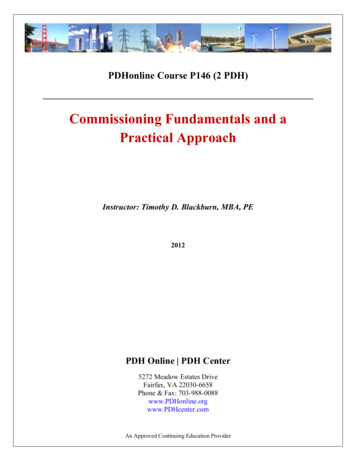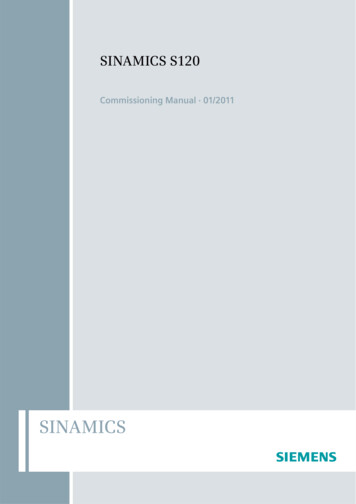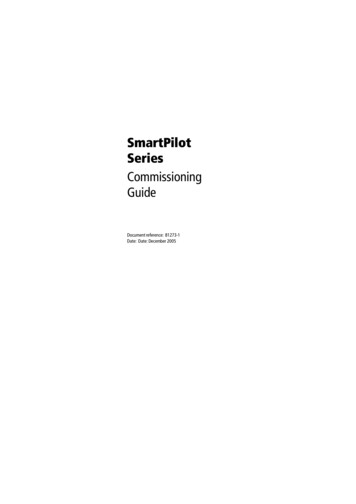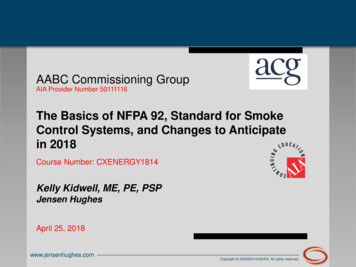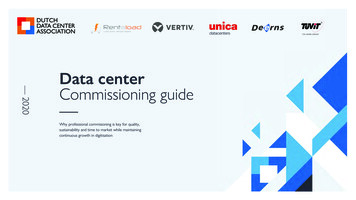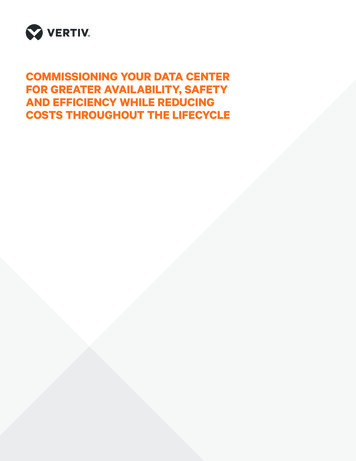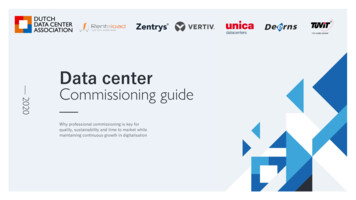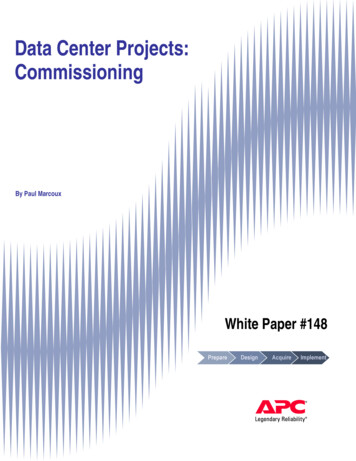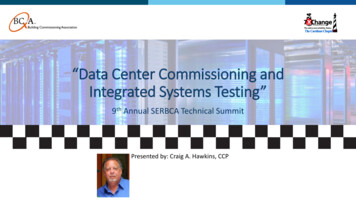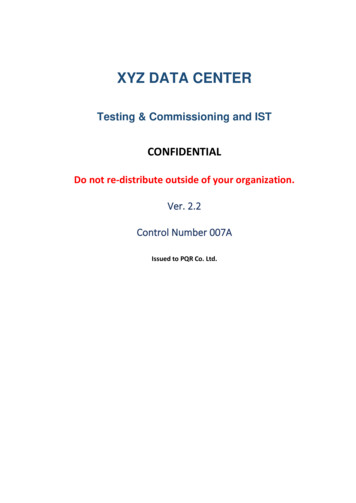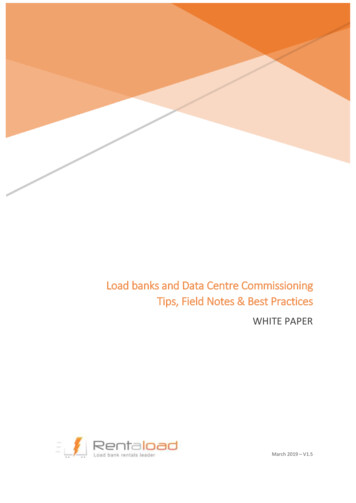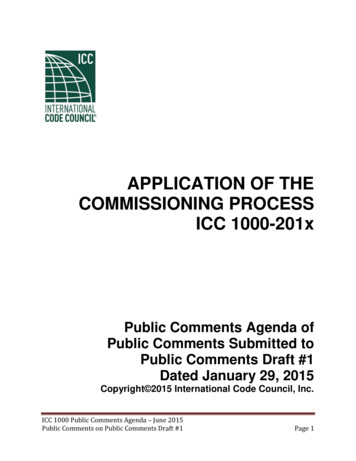
Transcription
APPLICATION OF THECOMMISSIONING PROCESSICC 1000-201xPublic Comments Agenda ofPublic Comments Submitted toPublic Comments Draft #1Dated January 29, 2015Copyright 2015 International Code Council, Inc.ICC 1000 Public Comments Agenda – June 2015Public Comments on Public Comments Draft #1Page 1
ICC 1000- 01Public Comments Draft 1Proponent: Proponent: Raymond Bert, Executive Director, AABC CommissioningGroup.General:APPLICATION OF THE COMMISSIONING PROCESS ICC 1000-201xPUBLIC COMMENTS DRAFT #1Comment: This letter is in response to the public comment period for ICC 1000-201x Standard for theCommissioning Process. In a conference call with the major commissioning organizations on April 20 inwhich we made some of our issues with the proposed Standard known, Dominic Sims indicated that wecould submit these in the form of a letter rather than using the comment form.ACG has serious concerns that if released in its present form without major rewrites, ICC 1000 hassignificant potential to create confusion in the industry. This would have major impacts on both therequired scope of commissioning services as well as the proper role of the commissioning provider.Although we have heard on numerous occasions that the intent of ICC 1000 is to serve as guidance forcode officials regarding commissioning, the fact that it is written as a standard with mandatory language,and that it is called a "Standard for Commissioning" mean that it will inevitably be seen as a standard thatproviders should follow and be held to. (Section 102.1 Applicability, for example, says that "Thecommissioning process of buildings and systems shall comply with this standard.")In addition to that basic confusion of the document's intent and proper use, ICC 1000 conflicts with theexisting ANSI standard for commissioning, ASHRAE Standard 202-2013, Commissioning Process forBuildings and Systems, which is accepted by all of the major commissioning organizations as thebenchmark for minimum requirements for commissioning. ICC 1000's definitions, the implied minimumrequirements, and its descriptions of the commissioning process are in many cases at odds with 202.Finally, ACG has concerns that in a number of places in ICC 1000, the language can easily be interpretedto place responsibility for code compliance on the commissioning provider. In addition to being animproper role for the commissioning provider—who is an advocate for the building owner helping toensure that the building works as intended, and not a code official—the liability issues that would becreated would likely cause the cost of commissioning to increase dramatically, while driving manycompanies out of the business entirely.In summary, ACG strongly urges that ICC take a fresh look at this document and revise it significantly tobetter reflect its intent of education and guidance for code officials with respect to commissioning. Weagree that code officials are a key constituency that needs to understand commissioning's place in theconstruction process, and we are willing to work with you to advance this goal.Bert1-Public Comments Draft1Committee Action:ASAMDICC 1000 Public Comments Agenda – June 2015Public Comments on Public Comments Draft #1Page 2
ICC 1000-02Public Comment Draft #1Proponent: Richard W. Dennis, PE, LEED AP (BC&D), CCP, CPMP, DLBAssociatesGeneral Comment:There are literally dozens of groups who already publish standards, guidelines, best practices andprocesses to conduct commissioning.Several of the best ones are holistic in their scope and provide useful standards and guidelines forbuilding lifecycle commissioning (Items 1-6 listed below), while many others are very parochial in nature often dealing with a single discipline, system type, or purpose.The most nationally recognized and commonly referenced / utilized building commissioning standardsand best practices are:1. Building Commissioning Association: “New Construction Building Commissioning Best Practice”2. ASHRAE Standard 202 : “The Commissioning Process for Buildings and Systems”3. ASHRAE Guideline - 0 - 2013: “The Commissioning Process”4. AABC Commissioning Group: “ACG Commissioning Guideline”5. California Commissioning Collaborative: “California Commissioning Guide: New Buildings”6. American Society for Healthcare Engineering: “Health Facility Commissioning GuidelinesThere are additionally a host of other guidelines intended to be used in conjunction with the masterguidelines above such as NETA Commissioning Guidelines, ASHRAE HVAC and ASHRAE SmokeControl System Commissioning Guidelines.In addition, there are published guidelines for existing building commissioning; many by the sameorganizations listed above. These existing building requirements are often more likely to be encounteredin local code requirements than in new construction. Codes such as New York City’s Local Law 87requiring energy audits and retro-commissioning once per decade is a salient example.It is my professional opinion the building commissioning community does not need anothercommissioning process description or standard and would suggest the ICC board who are developing thisstandard consider options for inclusion of code identification requirements into the existing industryreferenced standards. My professional recommendation as the most commonly utilized reference acrossthe building commissioning community is ASHRAE Guideline - 0 - 2013.I would also STRONGLY recommend that ICC include certified commissioning experts as key memberson your development group going forward, to both help ensure there is a well experienced and detailedunderstanding of the building delivery and commissioning processes, as well as detailed understanding ofthe critical interfaces and responsibilities (legal and otherwise) within the building delivery project team(Owner, Engineer of Record, Contractor, Commissioning Agent, AHJ).Dennis5-Chapter 4Committee Action:ASAMDICC 1000 Public Comments Agenda – June 2015Public Comments on Public Comments Draft #1Page 3
ICC 1000-03Public Comments Draft 1Proponent: Richard W. Dennis, PE, LEED AP (BC&D), CCP, CPMP, DLBAssociates.General:APPLICATION OF THE COMMISSIONING PROCESS ICC 1000-201xPUBLIC COMMENTS DRAFT #1Comment: The purpose of this document / standard appears to be a means of placing a requirement ofthe CxA to back-check code compliance of installations which have already been signed and sealed bylicensed / professional engineers (i.e. Engineer of Record) and installed by licensed tradesmen. Whilethis is a noble endeavor and even potentially doable, the process defined in this document will not meetthat need in my professional opinion.Upon several read-throughs of the document, it does not appear to address the already existingcontractual and legal responsibilities for code compliance by the Engineer of Record, Architect of Record,installing contractors, general contractors / construction managers, and code officials.The primary issue that I highly recommend be addressed before this document is ever considered forrelease and implementation is what would stand to be conflicting liabilities for code compliance, bothduring and after the construction project, as well as the possible determination of code compliance by theCxA who may or may not have the necessary licensure to legally and ethically make such adetermination.To clarify this comment, below are two hypothetical but very plausible scenarios:Example 1a:A properly licensed Engineer of Record (EOR) seals electrical drawings and specifications for codereview and submits to the Authority Having Jurisdiction (AHJ), who, after interactions and obtainingclarifications, approves the design for permit and construction. Then a properly trained and licensedtrade contractor(s) installs the items, in this hypothetical example, case grounding connections, inwhat they understand as in accordance with the sealed and approved design plans and specificationsand within code requirements.Later in the project the Commissioning Authority (who may or may not be a licensed engineer orlicensed contractor or in any way legally authorized to assess code compliance) believes thegrounding connections to be out of compliance with current codes and documents the equipment /systems as not fit for acceptance, and documents the results of commissioning as requiring physicalremediation before acceptance by Owner.The EOR reviews the results of the CxA and disagrees with the interpretation of the CxA on whetherthe installation meets code requirements. Meanwhile project completion and AHJ inspection isdelayed since commissioning is not complete and facility is not accepted by Owner; incurringadditional costs to the Owner. In this scenario, to whom does the Owner appeal and who is liable forthe costs associated with any schedule extension and physical rework?Example 1b:Using the same scenario as Example 1a, but this time the CxA (who, again, may or may not be alicensed engineer or licensed contractor or in any way legally authorized to assess code compliance)performs inspections as called for in this standard and identifies the installation as being installed perrequirements of the sealed design drawings and specifications, and within code compliance, andrecommends acceptance of the installation by the Owner.The AHJ subsequently performs inspections and judges the installation as deficient and not incompliance with code, classifying this grounding as currently installed as an equipment and / or safetyICC 1000 Public Comments Agenda – June 2015Public Comments on Public Comments Draft #1Page 4
hazard and will not issue the Certificate of Occupancy until substantive physical corrections to theinstallation are made. The Owner consequently incurs substantial additional costs due to occupantcontractual delays. Who is then held fiscally liable for the delay and added costs?There are literally dozens of combinations of these type scenarios which could occur if this document isimplemented as currently written, each of which could present the same type of potential legal and fiscalissues.Has this document been reviewed by an appropriate legal counsel with engineering, construction andbuilding delivery experience? If not, it is strongly recommended the ICC has a thorough legal reviewconducted before proceeding any further with the development of this standard.Dennis01-101.1Committee Action:ASAMDICC 1000 Public Comments Agenda – June 2015Public Comments on Public Comments Draft #1Page 5
ICC 1000-04Public Comments Draft 1Proponent: Brian Perlberg, Esq., AGC Sr. Counsel of Construction Law andContracts, The Associated General Contractors of America.General:APPLICATION OF THE COMMISSIONING PROCESS ICC 1000-201xPUBLIC COMMENTS DRAFT #1Comment: Thank you for the opportunity to comment on International Code Council Standard forCommissioning ICC 1000-201x, Public Comment Draft #1 (“Standard”). We respectfully submit these briefcomments on behalf of the Associated General Contractors of America (AGC). AGC is the leadingassociation for the construction industry. AGC represents more than 26,000 firms, including over 6,500 ofAmerica’s leading general contractors, and over 9,000 specialty-contracting firms. More than 10,500service providers and suppliers are also associated with AGC, all through a nationwide network ofchapters.In general, AGC believes in parties possessing freedom of contract. The stated purpose of the proposedStandard is to specify legal requirements for “code officials, owners, and agencies to accept, implement,enforce, and document the commissioning process established in codes and standards.” While licensurerequirements for Commissioning Authority services might be something to consider, codification ofprescriptive legal requirements governing commissioning authority services as it appears in the draftStandard appear inappropriate. AGC requests further dialogue to better understand ICC’s intent.Construction industry stakeholders utilize a variety of project delivery methods. On a project, stakeholdershave diverse roles, project needs and capabilities. Empowering industry professionals and companies byproviding guidelines, recommended best practices, and standard contracts that are generated by industryassociations groups and experts are often preferred to more legal requirements. For instance, AGCactively participates in a coalition of more than 40 leading industry organizations through an effort calledConsensusDocs. The ConsensusDocs Coalition recently published a standard commissioning authorityagreement, entitled ConsensusDocs 820 Standard Agreement Between Owner and CommissioningAuthority (attached). This consensus-based contract is endorsed by AGC, AABC Commissioning Group(ACG), and several other industry organizations as a fair contract to begin contract negotiations, and toarrive at the delivery of commissioning services best suited to the type of project.Commissioning services can take many forms and functions. While it may not be ICC’s intent, as drafted,the Standard will inevitably be interpreted to be a one-size-fits all approach for commissioning services.Also, it is unclear as to what would be an acceptable equivalent standard under 103.1, because thestandards for judging equivalency are not included.Projects are increasingly employing varying degrees of collaboration among owners, constructors,specialty trades, and design professionals. The level of collaboration and input by constructors during thedesign and construction phases impacts the basis of design and design intent. It does not appear that thisStandard adequately takes into account greater degrees of collaboration, and may actual discouragecollaboration. For example, in more collaborative project delivery methods, the submittal process that ispresumed in section 405 is likely to be conducted less formalistic and include a dynamic dialoguebetween the parties.ICC 1000 Public Comments Agenda – June 2015Public Comments on Public Comments Draft #1Page
Proponent: Richard W. Dennis, PE, LEED AP (BC&D), CCP, CPMP, DLB Associates General Comment: There are literally dozens of groups who already publish standards, guidelines, best practices and processes to conduct commissioning. Several of the best ones are holistic in their scope and provide useful standards and guidelines for building lifecycle commissioning (Items 1-6 listed below), while .

